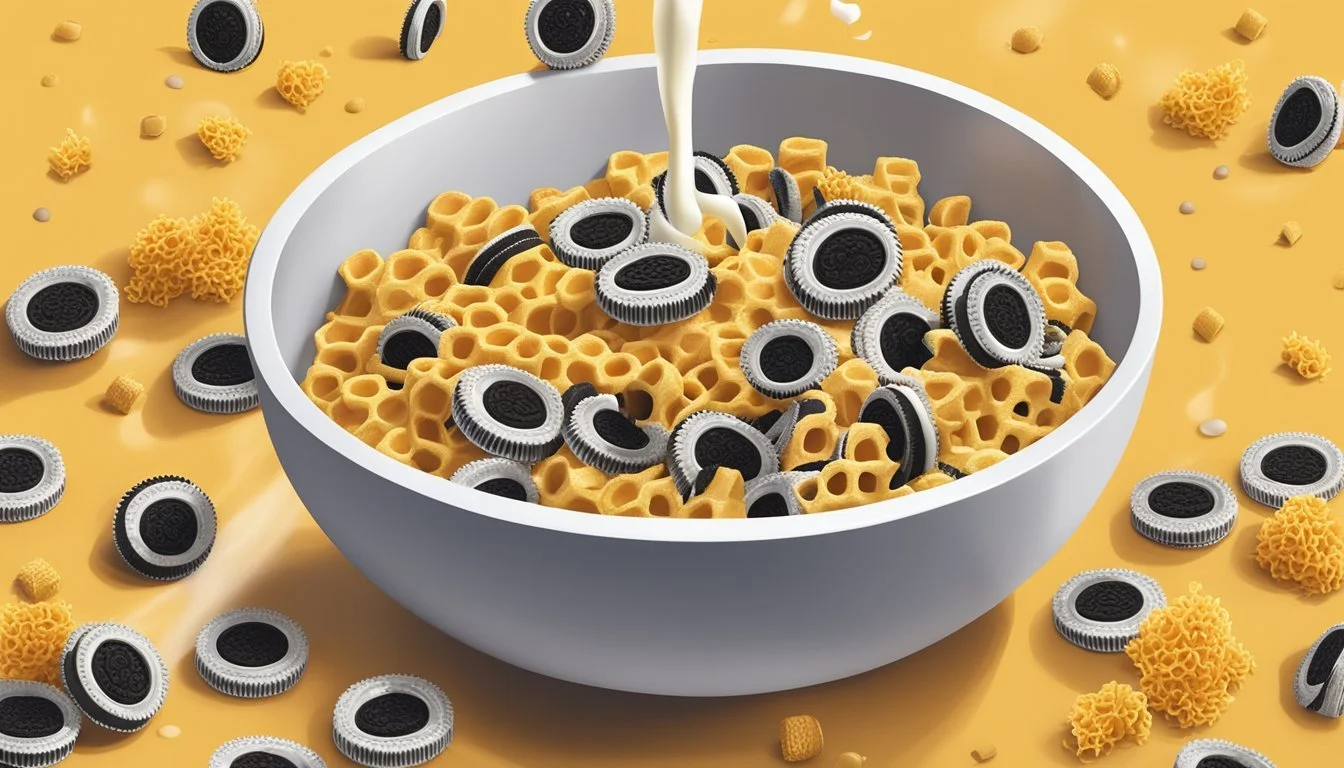Honeycomb vs Oreo O's
Comparing Breakfast Cereal Favorites
This Article is Part of Our Breakfast Cereal Guide with Details on Honeycomb Nutrition and Oreo O's Nutrition
When it comes to breakfast cereals, few debates are as intriguing as Honeycomb versus Oreo O's. Each of these cereal options offers a unique take on the morning meal experience. Honeycomb, known for its distinctive honey-flavored hexagonal pieces, has been a staple in many households for years. Its combination of crunch and subtle sweetness makes it a beloved choice for those who enjoy a classic, straightforward cereal.
On the other hand, Oreo O's are a more recent addition to the cereal aisle, capitalizing on the iconic flavor of Oreo cookies. This cereal provides a chocolatey, creamy taste that appeals to both kids and adults alike. While it may be less traditional, the fun and indulging aspect of Oreo O's cannot be overlooked. For those who have a sweet tooth in the morning, Oreo O's can make breakfast feel like a treat.
Nutritionally, the cereals differ significantly. Honeycomb tends to offer a composition that is lower in sugar compared to Oreo O's, which may be a critical factor for health-conscious consumers. Both cereals, however, provide essential vitamins and minerals, ensuring they contribute to a balanced diet. Whether you prioritize flavor, nostalgia, or nutrition, the choice between Honeycomb and Oreo O's comes down to what you value most in your breakfast routine.
Historical Background
Honeycomb and Oreo O's each have unique origins and development stories tied to their brands, Post Consumer Brands and Nabisco. These cereals have captured the nostalgia and taste buds of consumers through distinct flavors and strategic marketing efforts.
Origins of Honeycomb
Honeycomb cereal was introduced by Post in 1965.
It featured a honey-flavored, hexagonal-shaped cereal that stood out on the shelves. The cereal's creation capitalized on the popularity of honey as a natural sweetener.
With its light, airy texture, Honeycomb quickly became a breakfast staple. Marketing campaigns often showcased the cereal's kid-friendly appeal, including the memorable mascot Crazy Craving.
Post has continuously innovated with variations and limited-time flavors, keeping Honeycomb relevant to new generations. The cereal is also known for its colorful packaging and engaging commercials.
Development of Oreo O's
Oreo O's hit the market in 1998 and was developed by Post Consumer Brands in collaboration with Nabisco.
The cereal aimed to replicate the iconic Oreo cookie's taste, combining cocoa and chocolatey flavors with a creamy accent.
Originally, Oreo O's were widely popular until they were discontinued in 2007 due to a separation of Kraft Foods and Post.
In 2017, the cereal made a comeback primarily in South Korea through a partnership with Dongsuh Foods. This reintroduction celebrated the nostalgia associated with the original product.
Comparison reviews have noted differences between the U.S. version and the South Korean formula, particularly in chocolate intensity.
Oreo O's continue to capture the essence of cookies and cream, appealing to both longtime fans and new customers.
Nutritional Profiles
Honeycomb and Oreo O's are two popular cereals with distinct nutritional profiles. Below, the key components of each cereal are examined, highlighting their contents and impact on health.
What's in Honeycomb?
Honeycomb cereal primarily includes yellow corn flour, sugar, and whole grain oat flour. A serving size of Honeycomb cereal provides:
Calories: 130
Sodium: 150 mg
Fiber: Less than 1g
Sugar: 10g
Protein: 2g
This cereal also contains vitamins and minerals such as iron and calcium, but the sugar content stands out as a concern for those looking to reduce sugar intake.
Analyzing Oreo O's Ingredients
Oreo O's cereal focuses on providing a blend of recognizable ingredients like corn flour and wheat flour. A serving size of 1.25 cups (41g) contains:
Calories: 160
Total Fat: 2g (0g saturated fat)
Sodium: 220 mg
Fiber: < 1g
Sugar: 17g
Protein: 1g
Though it doesn't contain food dyes, the high sugar content makes it less ideal for those watching their sugar intake. Important nutrients such as fiber and protein are minimal, impacting its overall health appeal.
Dietary Considerations
Understanding the dietary aspects of Honeycomb and Oreo O's cereals is essential, especially for those with specific nutritional needs or allergies. This section dives into the allergen considerations for Honeycomb and examines whether Oreo O's fit special diet requirements.
Honeycomb and Allergens
Honeycomb cereal can be a choice for individuals without specific dietary restrictions. It generally does not contain common allergens like nuts or dairy.
However, it is not gluten-free as it contains wheat ingredients. This makes it unsuitable for individuals with celiac disease or gluten sensitivity.
For those following a vegan diet, Honeycomb is not optimal because it contains honey, which is an animal product. It is also not a keto-friendly choice because it has a substantial amount of carbohydrates and sugars per serving, which diverges from the low-carb requirements of a keto diet.
Oreo O's for Special Diets
Oreo O's cereal appeals to many due to its unique flavor but poses challenges for those with dietary restrictions. It contains wheat, making it non-compliant with gluten-free diets.
Vegans will find this option unsuitable due to the inclusion of whey, a dairy product. Oreo O's also carry a high sugar content, which might not align with healthy breakfast choices, especially for individuals focused on weight loss.
Its carbohydrate level is not compatible with keto diets, as it surpasses the low-carb threshold. While it does not contain artificial dyes, highlighting some consideration for ingredient transparency, other components still make it a less inclusive cereal for various diet plans.
Flavor Profiles and Variants
Honeycomb and Oreo O's offer distinct experiences, each appealing to different palates. Honeycomb brings a unique texture and sweetness, while Oreo O's provides a variety of flavors derived from the classic Oreo cookie.
Tasting Honeycomb
Honeycomb cereal is known for its light, sweet taste and crunchy texture. The cereal's honey-like flavor is derived from real honey, which gives it a natural sweetness that isn't overpowering.
The cereal pieces are shaped like small hexagons, adding a playful element to the eating experience. Each bite delivers a satisfying crunch, making it a popular choice for both children and adults.
Honeycomb maintains its texture well in milk, softening slightly but retaining enough crunch to stay enjoyable. It's a straightforward cereal with no flavor variants, focusing on delivering a consistent, honey-flavored experience.
Variety of Oreo O's Flavors
Oreo O's cereal extends the beloved Oreo cookie experience into breakfast. The primary flavor mimics the chocolate cookie with a hint of creaminess, reminiscent of the original Oreos.
Recently, Oreo O's have expanded to include variants like Oreo O's Mega Stuf, which offers a creamier texture akin to the Double Stuf Oreo cookies. There are also Golden Oreo O's, providing an option for those who prefer the vanilla-flavored golden Oreos.
Each variant maintains the core elements: chocolatey or vanilla flavor with a crunchy texture. These additions cater to different taste preferences, ensuring there's an Oreo O's flavor to suit a wide audience.
Oreo O's typically softens more quickly in milk than Honeycomb but lacks losing flavor. The variety available in Oreo O's makes it a versatile choice for those seeking different cereal experiences with the comfort of the familiar Oreo taste.
Manufacturing and Distribution
Honeycomb and Oreo O's are popular breakfast cereals produced by Post Holdings. Their manufacturing processes and global distribution strategies are key to their availability and quality.
Producing Honeycomb
Honeycomb cereal, part of Post's portfolio, is made using a combination of corn, oats, and real honey. The raw materials are sourced from trusted suppliers to ensure quality. The cereal undergoes an extrusion process that shapes it into the iconic honeycomb structure.
Post utilizes automated machinery for consistent production while adhering to strict quality control standards. The finished product is then packaged and shipped to retailers such as Walmart. The production facilities are located primarily in the United States, ensuring timely supply to North American markets.
Global Reach of Oreo O's
Oreo O's, originally launched by Post in collaboration with Kraft, features Oreo-flavored cereal pieces. It is produced using state-of-the-art machinery that allows for mass production. The recipe changes over the years, including the addition of real creme filling in 2001, improved its taste profile.
Oreo O's have a significant global presence. Although production is largely based in the U.S., the cereal is imported to various international markets. South Korea notably continued to produce and distribute Oreo O's even when it was temporarily discontinued in the U.S.
Strategic partnerships with global retailers and effective supply chain management ensure that Oreo O's are widely accessible. The brand leverages Post's distribution networks to maintain its presence in key markets around the world.
Market Presence
Honeycomb and Oreo O's cereals both have strong market presences, but they achieve this success through different strategies and brand histories.
Honeycomb's Position
Honeycomb, produced by Post Consumer Brands, has been a household name for decades. Originally introduced in 1965, Honeycomb has built its reputation with distinctive hexagonal shapes and a unique honey-flavored taste. The cereal's longevity is supported by consistent advertising and memorable commercials that have targeted children and families.
The brand leverages nostalgia with retro-themed campaigns while also introducing modern elements to maintain relevancy. Honeycomb has a solid market share due to its broad consumer appeal. Its packaging often highlights its long history, reassuring customers of its established quality and consistency.
Oreo O's Brand Evolution
Oreo O's, another product from Post Consumer Brands, has had an interesting journey since its introduction in 1998. Initially discontinued in 2007, the cereal made a comeback in 2017 due to high consumer demand and nostalgic interest. The marketing strategy leverages the iconic Oreo brand, known worldwide for its cookies.
Recent advertising spots and social media campaigns have reintroduced Oreo O's to both new and returning customers, emphasizing the novelty of having a beloved cookie flavor for breakfast. The cereal's unique selling proposition combines the familiarity of Oreos with a new breakfast context. This approach has helped Oreo O's capture significant attention in the competitive cereal market.
Consumer Perspectives
Honeycomb and Oreo O's are two breakfast cereals with distinct flavors and loyal fan bases. Their reviews highlight differing opinions on taste, nutritional value, and overall appeal.
Honeycomb Reviews
Honeycomb cereal garners mixed reviews. Consumers often praise its light and crispy texture and sweet honey flavor. Many appreciate its large, hexagonal shape, which makes it unique among cereals.
Consumer reports often mention that Honeycomb is not overly sweet, making it a versatile choice for both kids and adults.
Ratings for Honeycomb usually fall within the mid-to-high range. Taste tests reveal that while some prefer its subtle flavor, others criticize it for lacking enough sweetness compared to other cereals.
Nutritionally, reviews note that it has modest sugar content but also point out its minimal fiber, which impacts its health benefits.
Public Response to Oreo O's
Oreo O's cereal has a strong following, especially among those who enjoy the classic Oreo cookie flavor. It's described as having a bold, chocolatey taste with a hint of creaminess that appeals particularly to young adults.
From a taste test perspective, this cereal is often highlighted for its rich flavor and crunch. Consumers note that imported versions may differ slightly in terms of chocolate intensity.
Ratings for Oreo O's frequently trend higher than Honeycomb's, reflecting its distinctive taste that aligns closely with a beloved snack. Reviews often emphasize its appeal as a treat rather than a traditional breakfast option due to its higher sugar content.
Consumer reports sometimes mention that Oreo O's can be too sweet for some, suggesting it might be better suited for dessert or an occasional indulgence.
Comparative Analysis
Honeycomb and Oreo O's are two popular cereals, each with unique characteristics that appeal to different market segments. This analysis will explore Honeycomb's presence in the market and compare Oreo O's to its competitors.
Honeycomb in the Market
Honeycomb cereal has been a staple in breakfast aisles for decades. Known for its distinctive shape and honey-flavored taste, it primarily appeals to children and nostalgic adults.
The cereal is marketed for its large, crunchy honeycomb pieces that readily absorb milk, offering a satisfying breakfast experience.
By positioning itself alongside other cereals like Froot Loops and Raisin Bran, Honeycomb maintains a competitive edge through unique branding and nostalgic value. The cereal's enduring appeal is bolstered by consistent advertising strategies and brand loyalty.
Oreo O's Versus Competitors
Oreo O's, initially discontinued and then reintroduced, bring the popular Oreo cookie flavor to breakfast. Positioned to attract fans of the iconic cookie, it competes with cereals like Pebbles and Life.
In terms of flavor, Oreo O's stand out for their distinct cocoa and cream taste. Compared to Grape-Nuts, which focus on health and simplicity, Oreo O's cater to those seeking a more indulgent morning treat.
The cereal has found a niche by balancing novelty and familiarity, which sets it apart from competitors. While Honeycomb targets nostalgic buyers, Oreo O's attract individuals desiring a unique yet familiar flavor.
Closing Thoughts
When comparing Honeycomb and Oreo O's, several factors come into play.
Health Considerations
Honeycomb typically contains less sugar than Oreo O's, making it a slightly better choice for those watching their sugar intake. Both cereals provide essential vitamins and minerals, but for a more balanced start to the day, Honeycomb might have an edge.
Final Recommendations
Choose Honeycomb if you prefer a lighter, less sweet breakfast option. The cereal's honey flavor is appealing without being overwhelming. For those who love a richer, chocolatey taste, Oreo O's delivers a nostalgic treat reminiscent of cookies and cream.
Purchasing Advice
Look out for promotions and discounts on both cereals. Many grocery stores offer deals on breakfast cereals, so you might find both Honeycomb and Oreo O's at competitive prices. Additionally, consider checking online retailers where bulk purchases can provide better value.
In essence, the choice between Honeycomb and Oreo O's depends largely on personal taste and dietary preferences.










